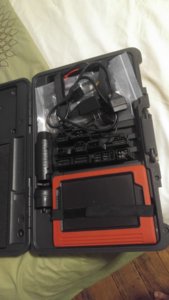See, here's the thing. The sensor is just two little pieces of metal that rub together. That's it. They rub back and forth, and the resistance between the input side and the sense side changes. The most likely failure mode is for the little stationary bit to wear out right where the slidey bit spends the most time rubbing on it. That spot is at about 1/4 to 1/2 throttle - right where the throttle plates spend the most time at cruise. Somewhere right there in the middle, they start to wear out, and they don't conduct electricity as well as they should. When that happens, the computer gets bad info. Depending on the car, it either thinks that the throttle is suddenly WTFO, or snapped shut. So it gives a bunch of gas, or none at all, then the O2 data rolls in, and it contradicts the TPS, so the computer tries to compensate, but its outside of the trim tables, so it doesn't know WTF to do, and the result is surging or stalling. It'll happen all the time, usually riding down the road at part throttle. It doesn't matter what gear you're in, or whether the tcase is in 4lo. It might happen more when it's raining (humidity), or more after the car has been running for a while (heat), but it happens pretty much all of the time, and it gets progressively worse with time.
While the TPS might still be the problem (who knows at this point), we can already see the most likely failure mode for a TPS doesn't coincide with the described problem. But that doesn't mean we shouldn't cross it off the list conclusively.
Since we might have some defective wiring, or a corroded fuse socket, or a bad ECM, marginal battery, bad ground, etc, etc, etc, we want to isolate the problem. Does THIS part (the TPS) need to be replaced?
The easiest way to find out conclusively is to unplug it, probe the connector with a cheap analog meter, and slowly open and close the throttle. If the needle moves smoothly back and forth, the TPS is good. If it moves correctly, then jumps around wildly (likely somewhere in the middle of the sweep), the TPS is bad. Those two little bits of metal we talked about earlier? They give zero shits what the impedance of your meter is.
The problem with using a voltmeter to troubleshoot the TPS is that it doesn't tell you for sure that the TPS is bad. It tells you that the TPS voltage is low, or too high, or that it changes sometimes for an unknown reason. If you're Mr. supersmart mechanic guy, that might be okay with you. You've been around the block, you know it's garbage in, garbage out, and you've probably already watched the scanner data and seen the same behavior. But if you're trying to describe the troubleshooting process to somebody else who may or may not know anything about how any of this shit works, why confuse them with any of this extraneous shit? Put a meter on the TPS, cycle it, check it off the list, and move on. I mean, fuck, I've had unrelated problems randomly change the voltage on the 5V rail. So you're out there troubleshooting the TPS output voltage, and meanwhile a charcoal canister evap sensor or some stupid shit is shorting out and dropping the 5V to 4.2V. But you don't know that, because you went out and spent $300 on a fancy meter so that you could watch the TPS output voltage, because somebody told you there was no way you could properly troubleshoot two little bits of metal with a $10 meter.




